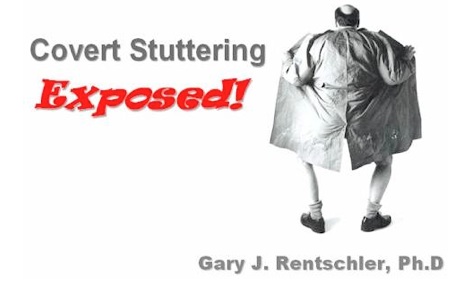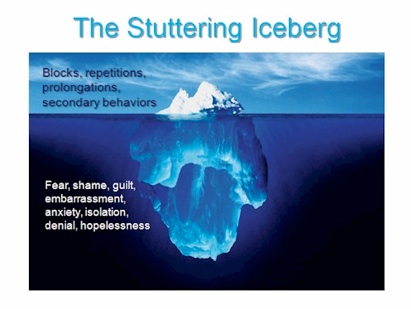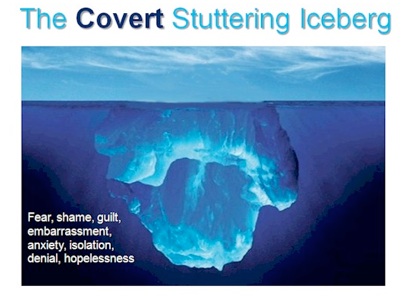Covert Stuttering Exposed!
 |
About the presenter: Gary Rentschler, Ph.D. CCC.SLP is Clinic Director in the Department of Speech-Language Pathology at Duquesne University in Pittsburgh, Pennsylvania, where he directs the Adult and Adolescent Stuttering Program. A board-recognized Fluency Specialist, Gary also was recognized as Speech-Language Pathologist of the Year 2002 by the National Stuttering Association. |


from Pennsylvania, USA
Can person who has no repetitions, prolongations, or blocks in their speech still be considered to stutter? Covert stuttering is a type of stuttering in which there are very few visible signs of speech disruptions or behaviors that commonly accompany stuttering. But in many instances, the handicap of their speech disorder impacts their life as if they stuttered on every word.
Some people who stutter can effectively mask the symptoms of their stuttering so that others don't detect that anything is different about their speech. Listeners might comment that their speech is a little rushed or it contains more revisions than ordinary, but they would never think that it was stuttering.
For people who stutter covertly (PWSC) the fear of stuttering is greater than the consequences of others finding out that they stutter. So the PWSC develops ways of hiding their stuttering by changing words, taking pauses, ending utterances prematurely, or not speaking at all, in order that others not know they stutter. These extreme avoidance strategies increase the fears of stuttering and the PWSC needs to guard against stuttering in every speaking situation.
The casual observer might ask, "If you can successfully mask your stuttering, why is it a problem?" But for the PWSC, the burden associated with trying to hide their stuttering is usually equal to that who stutter openly.

Stuttering is a problem that has outward symptoms (blocks, repetitions, and prolongations of sounds and body movements that accompany the speech symptoms) and inward symptoms (feelings, beliefs and emotions which relate to the speech differences). Some compare stuttering to an iceberg. Only 10% of an iceberg is visible above the surface of the water; 90% remains below the surface and is not seen. With stuttering, there are the visible parts (the speech repetitions, head movements and the like) that are readily observable, and there are the feelings, beliefs and emotions that lie below the surface, unseen by the casual observer.

Covert stuttering is a form of stuttering in which the person goes to extraordinary lengths to conceal any visible or detectable components of their stuttering, yet the feelings, beliefs, and emotions about their stuttering are just the same as others who stutter openly. Their iceberg might look like the one above - with nothing observable to others on the surface, but strong feelings of fear, embarrassment and the like lying below.

Being "covert" is
- Having excessive fear of being perceived by others to have a difference in the way they speak
- Constantly fearing their "stuttering secret" being uncovered
- Feeling guilty for making the listener feel uncomfortable because of their stuttering
- Denying stuttering or the need to work on it
- Feeling shame, devaluating oneself, or fostering the need to hide stuttering

People who stutter covertly sometimes feel as though they don't really belong to the "fluent world" or the "stuttering world", instead falling somewhere uncomfortably between each. Others who stutter often wonder what the PWSC is making such a fuss about; because they don't have outward symptoms of stuttering, how bad can that be? Nonetheless, PWSC worries about their speech in the same ways as others who stutter. Fluent speakers don't understand why the PWSC seems so anxious about speaking. The PWSC feels like they straddle the divide between the two groups, not truly belonging in either. As a result, they feel isolated and different from everyone else.
Treatment Paradigms for Stuttering
Those seeking treatment for covert stuttering learn to face the fears that have resulted in the decision to hide their stuttering. Where therapy for stuttering traditionally begins by focusing on the speech aspects of stuttering, therapy for covert stuttering addresses changing attitudes about stuttering, reducing the fears and penalties of stuttering, and building a support team before developing strategies to modify speaking behaviors.
- Typical Fluency Shaping Paradigm for Stuttering
- Work on speaking in ways that mimic fluent speech production
- Typical Stuttering Modification Paradigm for Stuttering
- Work on managing the moment of stuttering through modification and acceptance
- Paradigm for Covert Stuttering
- First, attack the fear of stuttering through education, confrontation, reality, and building a tolerance for 'little bobbles' in speaking
- Then move into traditional stuttering modification therapy
- Changes in cognitive and affective components of stuttering are essential - Confronting stuttering is an attack on the self and is not always comfortable
- Group therapy is the recommended to
- reduce feelings of isolation
- establish a group affiliation
- provide examples of courage
- Desensitization activities - Challenge negative thoughts and beliefs
Starting the Journey
Things you can do if you are a PWSC. . .

- Talk more openly about your stuttering
- Mention stuttering to your family, friends, co-workers
- Advertise your stuttering by wearing a stuttering t-shirt or pin or carrying coffee mug around office which mentions stuttering
- Stutter voluntarily on non-feared words
- Make phone calls to strangers and insert voluntary stutters
- Leave reading materials about stuttering out in the open for others to see
- Start a conversation about stuttering with someone
Start Small, but do something every day toward reaching your goal.

